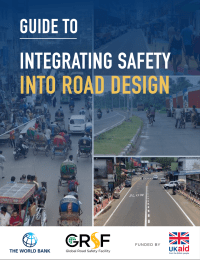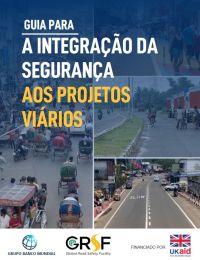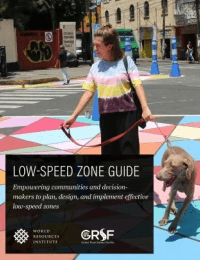Publications
31-40 of 62
-
-
Road Infrastructure
Practical Guide for Road Safety Auditors and Inspectors in Ukraine (Ukrainian)
July 2022
-
-
-
Traffic crashes are a leading cause of death and serious injury worldwide; most notably, they are the leading cause of death and serious injury among young people aged 5–29. Higher motor vehicle speeds increase the likelihood and severity of crashes.
-
Low-speed zones have emerged as one of the most promising strategies for speed management. They can be appropriate in many different contexts and at various scales, as exemplified by case studies of successful projects around the world.
-
Low-speed zones in cities need to be well-planned, well-designed, and well-built, to maximize safety and other benefits.
-
Physical traffic-calming measures and target speeds of 30 kilometers/hour (km/h) or lower have the greatest proven safety benefits.
-
Key considerations for implementation include stakeholder engagement, site selection (including risk: pedestrian/vulnerable road user presence), enforcement, evaluation, and the adaptation of basic principles for low-speed zone design to the local context.
-
Road Safety Data
Directrices Para la Realización de Evaluaciones de Datos de Seguridad Vial (Spanish)
July 2022
-
Road Safety Data
Guide pour la Conduite de Revues de Données de Sécurité Routière (French)
July 2022
- Xác định ngắn gọn giá trị thực tế mạnh mẽ của AE trong việc cứu sống và giảm thương tích.
- Xác định các vấn đề và tiêu chí cần xem xét trước khi bắt đầu thực thi tự động. Xác định các bước cần thực hiện để đạt được sự sẵn sàng cho việc thực thi tự động. Xác định các vấn đề để cải thiện các hệ thống thực thi tự động hiện có.
- Cung cấp danh sách kiểm tra để đảm bảo cân nhắc đầy đủ các vấn đề để đánh giá mức độ sẵn sàng triển khai hệ thống AE hoặc cải thiện hệ thống hiện có.
- Identificar brevemente el poderoso valor práctico de la AE para salvar vidas y reducir las lesiones.
- Identificar los problemas y criterios que se deben considerar antes de comenzar la aplicación automática de la ley. Identificar los pasos que se deben tomar para lograr la preparación para la aplicación automática de la ley. Identificar los problemas para mejorar los sistemas de aplicación automática de la ley existentes.
- Proporcionar una lista de verificación para garantizar que se tenga en cuenta adecuadamente los problemas para evaluar la preparación para implementar un sistema de AE o mejorar un sistema existente.

This guide focuses on elements of safe road and roadside designs for road networks that can provide safe mobility to all road users
A substantial reduction in road deaths will only be feasible if concerted efforts are made, following the “Safe System” approach involving all elements of road safety, management, and delivery. This includes all pillars of the Safe System—starting from road safety management, safe roads and roadsides, safe speed, safe vehicles, safe road users, and post-crash care. This guide focuses on elements of safe road and roadside designs for road networks that can provide safe mobility to all road users, as well as complementary changes to improve speeds, vehicle safety, road user behaviors, and post-crash care. A balanced road design must take into account these complementary system elements to maximize safety benefits. The energy carried by a moving object is proportional to the square of its speed. A well-designed “forgiving roadside” ensures that this energy is dispersed in a crash, and as a result, less energy is transferred to the occupants.
Road infrastructure design plays a vital role in road safety outcomes. Safe infrastructure supports other road safety pillars by encouraging appropriate road user behavior (such as appropriate speed and correct lane position) and by providing a forgiving road environment if things go wrong. Poorly designed road infrastructure can give rise to dangerous road user behavior. One of the key realizations of the Safe System approach is that drivers make mistakes and will continue to do so, even if we can reduce how often these occur. This road user error has long been recognized as a significant contributor to poor road safety outcomes. However, roads of any given speed can be designed to reduce the likelihood of crashes occurring, and there is very clear evidence that the severity of outcomes when crashes do occur is significantly influenced by the road design. Even if a crash still occurs, improved road infrastructure can save many lives and prevent debilitating injuries.
The Safe System approach highlights that a shared response is required to address road safety. This means that road users will continue to take responsibility for their actions, for instance by being alert and compliant with road rules. However, it is also recognized that road managers and designers have a significant responsibility to provide a road system that protects all road users. This can be achieved through appropriate designs of roads.

Chi phí thực sự của việc chạy quá tốc độ đối với con người và môi trường là bao nhiêu? 6 biểu đồ sau đây sẽ cho biết câu chuyện
Tác động của tốc độ đối với sự an toàn của người tham gia giao thông, tình trạng tắc nghẽn, ô nhiễm và tổng chi phí đi lại trên đường bộ thường bị hiểu sai: thường dựa trên những giả định sai lầm, với những tác động được coi là hiển nhiên, không xem xét nhiều tác động, nhiều bên liên quan chuyển chi phí ra bên ngoài và đánh giá thấp tác động (đặc biệt là chi phí kinh tế khi chạy với tốc độ cao). Mục đích của bản ghi chú ngắn này là cung cấp thông tin về những mối quan hệ này có liên quan đến các chính sách, thiết kế và hoạt động cơ bản của giao thông đường bộ. Bằng chứng rõ ràng cho thấy tầm quan trọng của việc quản lý tốc độ di chuyển để đảm bảo an toàn giao thông, hiệu quả, cải thiện sự hòa nhập và khí nhà kính (GHG) cùng các khí thải khác. Do đó, quản lý tốc độ là đòn bẩy chính sách mạnh mẽ đối với nhiều vấn đề cần được giải quyết để có khả năng di chuyển bền vững.
Giảm tốc độ di chuyển là một cơ hội lớn nhưng chưa được đánh giá đúng mức để cải thiện sự an toàn, tác động của biến đổi khí hậu đối với giao thông, sức khỏe, sự hòa nhập, nền kinh tế và trong một số trường hợp là tình trạng tắc nghẽn. Quản lý tốc độ có thể đạt được thông qua một loạt các biện pháp can thiệp bao gồm cơ sở hạ tầng đường bộ và công nghệ xe cộ, cũng như thực thi và thúc đẩy.
Sáu biểu đồ được trình bày trong ghi chú này kể một câu chuyện mạnh mẽ, trong phạm vi các lợi ích của việc quản lý tốc độ.

¿Cuál es el costo real del exceso de velocidad para las personas y el medio ambiente? Estos 6 gráficos lo cuentan.
Los impactos de la velocidad en la seguridad de los usuarios de la vía, en la congestión, en la contaminación y en los costos totales de los viajes por carretera son ampliamente malinterpretados: a menudo se basan en suposiciones erróneas, con efectos que se toman como evidentes, no se consideran múltiples impactos, muchas partes interesadas externalizan los costos y se subestiman los impactos (especialmente los costos económicos de las velocidades más altas). El propósito de esta breve nota es proporcionar información sobre estas relaciones relevantes para las políticas fundamentales del transporte por carretera, el diseño y la operación. La evidencia bien establecida muestra la importancia de gestionar las velocidades de viaje para la seguridad vial, la eficiencia, la mejora de la inclusión y las emisiones de gases de efecto invernadero (GEI) y otras. Por lo tanto, la gestión de la velocidad es una fuerte palanca de política para la amplitud de cuestiones que deben abordarse para la movilidad sostenible.
La reducción de la velocidad de viaje representa una oportunidad importante, aunque subestimada, para mejorar la seguridad, los impactos del cambio climático de los viajes, la salud, la inclusión, la economía y, en algunas circunstancias, la congestión. La gestión de la velocidad se puede lograr mediante una serie de intervenciones, que incluyen la infraestructura vial y la tecnología de los vehículos, así como la aplicación de la ley y la promoción.
Los seis gráficos presentados en esta nota cuentan una historia poderosa sobre la gama de beneficios de la gestión de la velocidad.

Після майже двох десятиліть досвіду проведення аудиту безпеки дорожнього руху (RSA) у всьому світі ця процедура визнана одним із найефективніших інженерних інструментів. RSA є високоефективним і економічно вигідним інженерним інструментом для підвищення безпеки на дорогах. Набагато дешевше виявити недоліки безпеки дорожнього руху в процесі проектування, ніж пізніше після завершення будівництва. RSA є одними з найбільш рентабельних інвестицій, які може здійснити дорожнє управління.
У своїй Директиві ЄС № 2008/96 і поправці 2019/1936 щодо управління безпекою дорожньої інфраструктури Європейський Союз (ЄС) прийняв чітке рішення про те, що RSA буде обов’язковим для Транс’європейської мережі доріг (TERN) і магістральних доріг. Ця Директива містить інший інструмент під назвою «Інспекція безпеки дорожнього руху» (RSI) щодо недоліків безпеки існуючих доріг. RSI дуже схожий на процес аудиту безпеки дорожнього руху на етапі перед відкриттям новозбудованих доріг. RSI мають важливе значення для редизайну та модернізації існуючих доріг, і вони проводяться в багатьох країнах, щоб дати проектувальникам зрозуміти та вказати напрямки для покращення безпеки. Враховуючи те, що метою цього практичного посібника є надання практичних вказівок тим, хто проводить RSA та RSI, наведені приклади типових недоліків конструкції мають бути корисними як інспекторам безпеки дорожнього руху, так і аудиторам безпеки дорожнього руху.
Цей документ спирається на більш вичерпні рекомендації та посібники з техніки безпеки, згадані у подяках, але навмисно зосереджується лише на тих питаннях, які мають безпосереднє відношення до аудиторів/інспекторів з безпеки дорожнього руху та до звітів з безпеки дорожнього руху, які вони повинні підготувати, включаючи рекомендації щодо покращення.
Це спеціальне видання посібника, адаптованого до умов безпеки дорожнього руху та законодавства в Україні, фінансованого Глобальним фондом безпеки дорожнього руху (GRSF) Світового банку в рамках Ініціативи Bloomberg Philanthropies for Global Road Safety (BIGRS).
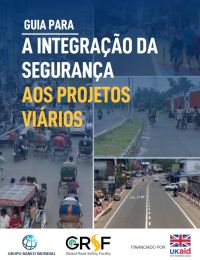
Este guia se concentra em elementos de projetos de estradas e acostamentos seguros para redes rodoviárias que podem fornecer mobilidade segura a todos os usuários das estradas
Uma redução substancial nas mortes nas estradas só será viável se esforços conjuntos forem feitos, seguindo a abordagem do "Sistema Seguro" envolvendo todos os elementos de segurança rodoviária, gerenciamento e entrega. Isso inclui todos os pilares do Sistema Seguro — começando pelo gerenciamento de segurança rodoviária, estradas e acostamentos seguros, velocidade segura, veículos seguros, usuários seguros das estradas e cuidados pós-acidente. Este guia se concentra em elementos de projetos de estradas e acostamentos seguros para redes rodoviárias que podem fornecer mobilidade segura a todos os usuários das estradas, bem como mudanças complementares para melhorar as velocidades, a segurança dos veículos, os comportamentos dos usuários das estradas e os cuidados pós-acidente. Um projeto rodoviário equilibrado deve levar em consideração esses elementos complementares do sistema para maximizar os benefícios de segurança. A energia transportada por um objeto em movimento é proporcional ao quadrado de sua velocidade. Um "acostamento tolerante" bem projetado garante que essa energia seja dispersada em um acidente e, como resultado, menos energia seja transferida para os ocupantes.
O projeto de infraestrutura rodoviária desempenha um papel vital nos resultados de segurança rodoviária. A infraestrutura segura dá suporte a outros pilares da segurança viária, incentivando o comportamento adequado do usuário da estrada (como velocidade adequada e posição correta na faixa) e fornecendo um ambiente de estrada tolerante se as coisas derem errado. Uma infraestrutura rodoviária mal projetada pode dar origem a um comportamento perigoso do usuário da estrada. Uma das principais conclusões da abordagem do Sistema Seguro é que os motoristas cometem erros e continuarão a fazê-lo, mesmo que possamos reduzir a frequência com que ocorrem. Esse erro do usuário da estrada é há muito reconhecido como um contribuinte significativo para resultados ruins de segurança viária. No entanto, estradas de qualquer velocidade podem ser projetadas para reduzir a probabilidade de ocorrência de acidentes, e há evidências muito claras de que a gravidade dos resultados quando os acidentes ocorrem é significativamente influenciada pelo projeto da estrada. Mesmo que um acidente ainda ocorra, uma infraestrutura rodoviária melhorada pode salvar muitas vidas e evitar ferimentos debilitantes.
A abordagem do Sistema Seguro destaca que uma resposta compartilhada é necessária para abordar a segurança viária. Isso significa que os usuários da estrada continuarão a assumir a responsabilidade por suas ações, por exemplo, estando alertas e em conformidade com as regras de trânsito. No entanto, também é reconhecido que os gerentes e projetistas de estradas têm uma responsabilidade significativa de fornecer um sistema viário que proteja todos os usuários da estrada. Isto pode ser alcançado por meio de projetos de estradas apropriados.
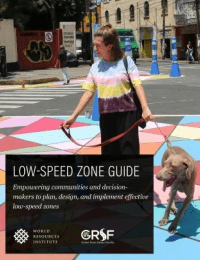
Every year approximately 1.35 million people lose their lives due to road traffic crashes. In many road crashes, speed plays a key role. As a result, managing speed has taken on great importance in cities around the world.
An effective method for reducing speed and improving road safety, especially in high-risk areas, has been to establish low-speed zones. This Low-Speed Zone Guide presents strategies for planning, designing, building, and evaluating low-speed zones. The guide intends to equip communities and decision-makers with the tools to implement low-speed zones that will suit their specific context.
Highlights:

En muchos países del mundo, las deficiencias en los datos o en la calidad de los mismos perjudican la formulación de políticas de seguridad vial basadas en evidencias. Si bien muchos países recopilan datos de seguridad vial, la recopilación no es necesariamente exhaustiva. Además, muchos países pueden desconocer las lagunas de datos en su sistema, lo que les impide analizar de manera sólida sus problemas de seguridad vial. Por lo tanto, las definiciones de datos de seguridad vial y los métodos de recopilación deben converger en criterios internacionales estándar, lo que permite realizar comparaciones en el espacio (entre países) y en el tiempo.
Esta es la razón de ser de los observatorios regionales de seguridad vial, que se han desarrollado, por ejemplo, en América Latina (OISEVI), África (ARSO) y Asia-Pacífico (APRSO). Presentan una oportunidad para realizar esfuerzos regionales conjuntos para mejorar, de manera armonizada, la recopilación y el análisis de datos de seguridad vial. Los observatorios regionales de seguridad vial promueven la adopción de un conjunto común de indicadores de seguridad vial basados en definiciones comunes y sirven como una vía para ayudar a los países a mejorar la gestión de sus sistemas de datos de accidentes.
Este documento está diseñado para ayudar a los revisores en la evaluación de la recopilación de datos de seguridad vial; Se debe tener en cuenta la gama completa de datos de seguridad. Esta tarea puede ser complicada porque la recopilación de datos de seguridad vial a menudo no se logra mediante actividades dedicadas a este fin, sino más bien mediante la combinación de otras fuentes. Por ejemplo, los informes de actividades de la policía o de los hospitales se utilizan para proporcionar material para fines legales o médicos. Las rutinas involucradas con frecuencia tienen una larga historia en la que la recopilación de estadísticas confiables y completas ha tenido una prioridad secundaria, en el mejor de los casos. Los diversos actores involucrados reflejan la compleja estructura del sistema judicial y ejecutivo de un país, que, por lo general, no están coordinados. En consecuencia, cualquier revisión del proceso de recopilación de datos requiere un cierto “trabajo de detective”.

Dans de nombreux pays du monde, les lacunes en matière de données ou de qualité des données compromettent l’élaboration de politiques de sécurité routière fondées sur des données probantes. Si de nombreux pays collectent des données sur la sécurité routière, la collecte n’est pas nécessairement exhaustive. En outre, de nombreux pays peuvent ne pas être conscients des lacunes de données dans leur système, ce qui les empêche d’analyser correctement leurs problèmes de sécurité routière. Par conséquent, les définitions et les méthodes de collecte des données sur la sécurité routière doivent converger vers des critères internationaux standard, permettant ainsi des comparaisons dans l’espace (entre les pays) et dans le temps.
C’est la raison d’être des observatoires régionaux de la sécurité routière, qui ont été développés, par exemple, en Amérique latine (OISEVI), en Afrique (ARSO) et en Asie-Pacifique (APRSO). Ils offrent l’occasion de déployer des efforts régionaux conjoints pour améliorer, de manière harmonisée, la collecte et l’analyse des données sur la sécurité routière. Les observatoires régionaux de la sécurité routière favorisent l’adoption d’un ensemble commun d’indicateurs de sécurité routière basés sur des définitions communes et servent de moyen d’aider les pays à améliorer la gestion de leurs systèmes de données sur les accidents.
Ce document est conçu pour aider les examinateurs à évaluer la collecte de données sur la sécurité routière ; Il convient de prendre en compte l’ensemble des données de sécurité. Cette tâche peut s’avérer compliquée, car la collecte de données sur la sécurité routière ne se fait souvent pas par le biais d’activités dédiées à cet effet, mais plutôt par le biais d’autres sources. Par exemple, les rapports d’activité de la police ou des hôpitaux sont utilisés pour fournir des informations à des fins juridiques ou médicales. Les routines concernées ont souvent une longue histoire dans laquelle la collecte de statistiques fiables et complètes a été, au mieux, une priorité secondaire. Les différents acteurs impliqués reflètent la structure complexe du système judiciaire et exécutif d’un pays, qui, en général, ne sont pas coordonnés. Par conséquent, tout examen du processus de collecte de données nécessite un « travail de détective ».

Hướng dẫn này được biên soạn để hỗ trợ một khu vực pháp lý xác định mức độ sẵn sàng chuyển sang thực thi tự động (AE). Camera tốc độ thực thi giới hạn tốc độ là một ứng dụng phổ biến của AE và có nhiều yếu tố pháp lý và hoạt động có hệ thống phải được áp dụng trước khi AE có thể có hiệu quả. Ví dụ, hình ảnh chính xác của một phương tiện chạy quá tốc độ, khi không có hệ thống cấp phép lái xe và đăng ký xe mạnh mẽ, thì giá trị an toàn đường bộ không cao. Điều quan trọng là, thực thi tốc độ tự động nên được coi là một phần của phương pháp quản lý tốc độ toàn diện bao gồm cả cơ sở hạ tầng đường bộ và cảnh sát ven đường. Quản lý tốc độ là một yếu tố cơ bản của Hệ thống an toàn.
Mục đích của tài liệu này:
Các hành vi bất hợp pháp khác, bao gồm không tuân thủ tín hiệu đèn đỏ, sử dụng điện thoại di động hoặc điện thoại di động, đi sai làn đường và không sử dụng biện pháp hạn chế cũng có thể được phát hiện bằng cách sử dụng phương pháp thực thi tự động. Tuy nhiên, tài liệu này áp dụng cụ thể cho việc thực thi tốc độ tự động, vì quản lý tốc độ đòi hỏi sự chú ý đáng kể trên toàn thế giới và đóng vai trò quan trọng trong việc giảm tử vong và thương tích do tai nạn giao thông đường bộ.

Esta guía se ha preparado para ayudar a una jurisdicción a determinar el nivel de preparación para pasar a la aplicación automática de la ley (AE). Las cámaras de control de velocidad que hacen cumplir los límites de velocidad son una aplicación común de la AE y hay muchos elementos legales y operativos sistémicos que deben estar en su lugar antes de que la AE pueda ser efectiva. Por ejemplo, una imagen precisa de un vehículo que va a exceso de velocidad, en ausencia de sistemas sólidos de licencias de conducir y registro de vehículos, tiene poco valor para la seguridad vial. Es importante destacar que la aplicación automática de la ley de velocidad debe considerarse como una parte de un enfoque integral de gestión de la velocidad que también incluye la infraestructura vial y la vigilancia en la carretera. La gestión de la velocidad es un elemento fundamental del Sistema Seguro.
Objetivos de este documento:
También se pueden detectar otras conductas ilegales, como desobedecer una señal de luz roja, usar el teléfono móvil o celular, usar un carril incorrecto y no usar el dispositivo de retención mediante un enfoque de control automatizado. Sin embargo, este documento se aplica específicamente al control automatizado de la velocidad, porque la gestión de la velocidad requiere una atención significativa en todo el mundo y desempeña un papel fundamental en la reducción de las muertes y lesiones por accidentes de tránsito.

